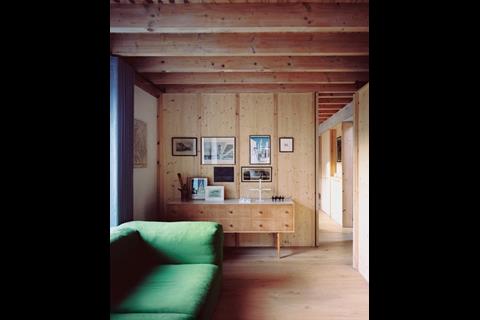Crystal Palace home designed by practice director Will Burges for his family
A home designed by the director of small London practice 31/44 Architects for his family has been chosen by RIBA as its 2024 House of the Year.
Six Columns, a two-storey house in Crystal Palace, was designed by Will Burges for himself, his wife and his two children.
The four-bedroom home, which is named after the six columns that form the main structure of the building, occupies a restricted wedge-shaped plot in the south London suburb.
Burges was inspired by a broad range of influences including the Barcelona Pavilion by Mies van der Rohe and the Case Study houses in California.
But RIBA said the “carefully balanced” house is still discrete and considerate in its surroundings, echoing the proportions and materials of neighbouring terrace houses while retaining its own individual character.
While the building features a brick facade and terracotta tile roof which blend with the rest of the street, RIBA praised touches of “bespoke grandeur” including concrete beams and a statement veined marble panel by the front door.
Inside, a central hall leads on one side into a “light and airy” kitchen with a “distinct raw aesthetic”, featuring unpainted pine cupboards, and on the other side into a living room characterised by exposed pine walls.

Outside, there are three separate garden spaces, including a low-maintenance, west-facing rainwater garden that channels water from all the roofs that tumble out of a huge spout and into a steel tank to prevent overflow and promote reuse.
RIBA president Muyiwa Oki described the house as a “beautifully crafted family home that cleverly incorporates Brutalist references and creative flourishes while retaining a strong sense of suburban belonging”.
> Also read: The Elizabeth Line wins 2024 Stirling Prize
“It shows what can be achieved when working with even the tightest of suburban sites, and its flexible, unfinished aesthetic offers a solution to futureproofed design: this is a home that can evolve with its occupants’ changing needs overtime,” Oki said.
“The generosity of space belies the limitations of this small garden plot. As we look for creative and practical solutions to the housing crisis, Six Columns offers a blueprint for bespoke urban infill development.”

Jury chair Je Ahn added: “What makes a great home? Building your own home is a hugely intensive endeavour; if you are lucky enough to do it at all, you will probably only ever do it once in your life.
“One-off houses are as unique and varied as we are as individuals, so often producing them needs a closer understanding between the client and architect.
“This philosophy of the home as a lifelong process might be a tricky concept in this fast-paced contractual world, however, Six Columns demonstrates an important message that we should all remember; your home is not a static slice of time, but continuously evolves with you.”
The house beat a shortlist of five other finalists to win the prize, including Surman Weston, Town Dowdall Architects, Hugh Strange Architects, Taylor Hare Architects and Studio Brassica Architects.


























3 Readers' comments